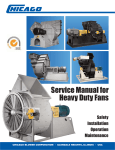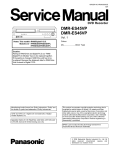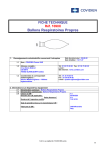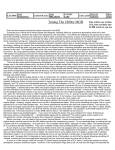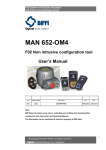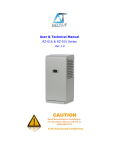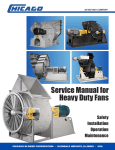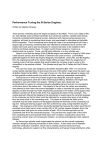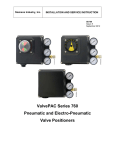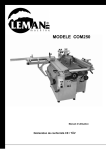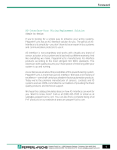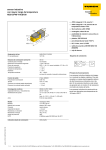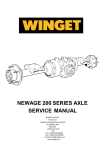Download Biffi Pneumatic Actuators, Models Alga/Algas/Algas-QA
Transcript
Biffi ALGA double acting pneumatic actuator Installation, Operation and Maintenance Manual 1. General warnings Important The manual is an integral part of the machine, it should be carefully read before carrying out any operation and it should be kept for future references. 1.1 GENERALITIES Table of contents 1 General warnings������������������������������������������ 1 2Installation����������������������������������������������������� 3 3 Operation and use����������������������������������������� 7 4 Operational tests and inspections������������� 23 5Maintenance.����������������������������������������������� 23 6Troubleshooting������������������������������������������ 30 7Layouts��������������������������������������������������������� 30 8 Date report for maintenance operations��� 39 installation, maintenance or use, or by irregular working conditions, the repairs will be charged according to applicable fees. The warranty and Biffi Italia S.r.l. liability shall lapse in the event that any modification or tampering whatsoever be performed on the actuator. Biffi Italia S.r.l. actuators are conceived, manufactured and controlled according to the Quality Control System in compliance with EN ISO 9001 international regulation. 1.1.1 Applicable regulation EN ISO 12100-1: 2005: Safety of machinery – Basic notions, general design principles. Part 1-Basic terminology, method. EN ISO 12100-2: 2005: Safety of machinery – Basic notions, general design principles. Part 2-Technical principles and specification. 2006/42/EC: Machine directive. 97/23/EC: Directive for pressure PED equipment. 2006/95/EC: Directive for low voltage equipment. 2004/108/EC: Directive for the electromagnetic compatibility. 94/9/EC: Directive and safety instructions for use in hazardous area. Note Biffi Italia S.r.l. pays the highest attention to collecting and verifying the documentation contained in this user manual. However Biffi Italia S.r.l. is not liable for any mistakes contained in this manual, for damage or accidents due to the use of the latter. The information contained is of exclusive reserved ownership of Biffi Italia S.r.l. and may be modified without prior notice. 1.1.2 Terms and conditions Biffi Italia S.r.l. guarantees that all the items produced are free of defects in workmanship and manufacturing materials and meet relevant current specifications, provided they are installed, used and serviced according to the instructions contained in the present manual. The warranty can last either one year from the date of installation by the initial user of the product, or eighteen months from the date of shipment to the initial user, depending on which event occurs first. All detailed warranty conditions are specified in the documentation forwarded together with the product. This warranty does not cover special products or components not warranted by subcontractors, or materials that were used or installed improperly or were modified or repaired by unauthorized staff. In the event that a fault condition be caused by improper www.pentair.com/valves © 2012 Pentair plc. All Rights Reserved. VCIOM-03129-EN 15/05 Biffi ALGA double acting pneumatic actuator Installation, Operation and Maintenance Manual Figure 1 - Data plate 1.2 Identification plate It is forbidden to modify the information and the marks without previous written authorization by Biffi Italia S.r.l. The plate fastened on the actuator contains the following information (figure 1). 1.3 Introducing the actuator The ALGA actuator is engineered and manufactured to provide maximum torque output with minimum supply pressure. ALGA actuators are suitable for the operation of any quarter turn operation such of ball, plug, butterfly valves or dampers, in both On-Off and Modulating heavy duty service. The actuator (see figure 2) is made up of a weatherproof Scotch yoke mechanism transforming the linear movement of the pneumatic cylinder (on closing or opening) into the rotary movement, which is necessary for operation. The angular stroke of the yoke is adjustable between 82° and 98° by means of the external mechanical stops screwed into the left wall of the mechanism housing and into the end flange of the pneumatic cylinder. The cover of the Scotch yoke mechanism is arranged for the assembly of the required accessories (positioner, signalling limit switches, position transducer, etc.) by means of proper matching units. The above mentioned accessories are operated by the actuator drive sleeve. The housing of the Scotch yoke mechanism has a flange with threaded holes to fix the actuator to the valve either directly or, if required, with the interposition of an adaptor flange or a mounting bracket. The actuator yoke has a hole with keyways suitable for the assembly of an insert bush the internal hole of which is machined (by Biffi or at customer's care), according to the shape and dimensions of the valve stem. Biffi can supply different types of control system following customer's requirements. The expected lifetime of actuator is approximately 30 years. Control system (optional) Valve position indicator Pneumatic cylinder Scotch yoke mechanism Valve coupling 1.4 Data sheet Supply fluid Air, nitrogen or sweet gas, special version available for sour gas Operating Standard: from –30°C to +100°C temperature Optional: from –60° to +200°C Supply pressure Please refer to technical document: 'Actuator data sheet' Output torque Up to 750,000 Nm (higher value with special version) Manual hand pump - MHP (optional) Hydraulic cylinder for ALGA-MHP models or second pneumatic cylinder for ALGA*2 double cylinder models (optional) Figure 2 - Identification of actuator parts 2 Biffi ALGA double acting pneumatic actuator Installation, Operation and Maintenance Manual 2. Installation 2.1 Checks upon actuator receipt • Check that the model, the serial number of the actuator and the technical data reported on the identification plate correspond with those of order confirmation (par. 1.2). • Check that the actuator is equipped with the fittings as provided for by order confirmation. • Check that the actuator was not damaged during transportation: if necessary renovate the painting according to the specification reported on the order confirmation. • If the actuator is received already assembled with the valve, its settings have already been made at the factory. If the actuator is delivered separately from the valve, it is necessary to check, and, if required, to adjust, the settings of the mechanical stops (par. 3.3) and of microswitches (if any) (par. 3.4). 2.2 Actuator handling Important The lifting and handling should be made by qualified staff and in compliance with the laws and provisions in force. Warning The fastening points are appropriate for the lifting of the actuator alone and not for the valve and actuator assembly. Avoid that during the handling, the actuator passes above the staff. The actuator should be handled with appropriate lifting means. The weight of the actuator is reported on the delivery bill. 2.4 Actuator assembly on the valve 2.4.1 Types of assembly For coupling to the valve, the housing is provided with a flange with threaded holes according to Biffi standard tables (SCN6200; SCN6200-1; SCN6201; SCN6201-1). The number, dimensions and diameter of the holes are made in accordance with ISO 5211, but for actuator models 0.3 to 6 the holes are drilled on the centerline in order to allow an easier assembly of an intermediate flange, when required. This intermediate flange (or spool-piece) can be supplied when the valve flange can not directly match the actuator flange in its 'standard' configuration. For the biggest actuator models, the actuator flange can be machined in accordance with the valve flange dimensions. The yoke has bored with keyways for coupling to the valve stem, the dimensions of which are according to Biffi standard tables SCN6200and SCN6201 (see next pages). Figure 3A, 3B - Lifting points for ALGA / ALGA- MHP / ALGA-MSJ actuators. 3A 1, 2 = Lifting points (obligatory) 3 = Balancing point 3B 2.3 Storage If the actuator needs storage, before installation follow these steps: • Place it on a wood surface in order not to deteriorate the area of valve coupling. • Make sure that plastic plugs are present on the pneumatic and electrical connections (if present). • Check that the cover of the control group and of the limit switch box (if any) are properly closed. If the storage is long-term or outdoor: • Keep the actuator protected from direct weather conditions. • Replace plastic plugs of pneumatic and electrical connections (if any) with metal plugs that guarantee perfect tightness. • Coat with oil, grease or protection disc, the valve coupling area. •Periodically operate the actuator (par. 3.3). 1 = Point of support 2 = Supports for lateral positioning Warning 3 = Don’t lay the actuator on tie rods of cylinder /s and don’t lay the actuator on accessories (manual hand pump, manual jackscrew, pneumatic control group etc.) 3 Biffi ALGA double acting pneumatic actuator Installation, Operation and Maintenance Manual Figure 4B Figure 4A Actuator models 0.3 to 6 Actuator models 14 to 42 Drive sleeve h₁ +0.5 0 h₁ +0.5 0 H max H max Drive sleeve +0.1 0 Ø d₂ Ø d₂ Ø d₃±0.2 Ø d₁ max +0 0 .4 Flow line 45º +0.2 Ø d₅ +0.1 'W'D10 +0.2 Ø d₅+0.1 +0,4 0 W K N. threaded holes PCD, number and size according to ISO 5211 (but the holes are on centerline instead of straddle the centerline) Flow line K 0 N. threaded holes PCD, number and size according to ISO 5211 N.16 holes flange N.12 holes flange N.4 holes flange N.8 holes flange Ø d₁ max D1 Ø d₄ Ø d₃±0.2 h₂ Ø d₄ h₂ +0.1 Top view of the Scotch yoke mechanism (actuator shown in closed position) Top view of the Scotch yoke mechanism (actuator shown in closed position) Coupling dimensions models 0.3 to 0.6 (mm) Actuator model 0.3 0.9 1.5 3 6 Ø d₁ 240 310 360 430 520 Ø d₂ 93 112 144 195 250 Ø d₃ 165 254 298 356 406 Ø d₄ M20 M16 M20 M30 M36 N 4 8 8 8 8 h₁ 5 5 6 9 14 h₂ 17 19 19 23 29 H max 127 150 190 200 260 Ø d₅ 70 86 112 157 200 W 12 14 18 25 28 K 75.6 96.6 119 167.8 212.8 h₁ 10 12 12 11 12 h₂ 29 32 32 32 32 H max 340 350 400 400 400 Ø d₅ 175 200 220 240 220 W 45 45 50 50 50 K 195.8 220.8 242.8 242.8 242.8 Coupling dimensions models 14 to 42 (mm) Actuator model 14 18 32 35 42 Ø d₁ 580 680 780 780 840 Ø d₂ 250 290 290 315 310 Ø d₃ 483 603 603 603 603 Ø d₄ M36 M36 M36 M36 M36 N 12 16 16 16 16 4 Biffi ALGA double acting pneumatic actuator Installation, Operation and Maintenance Manual Figure 4C Figure 4D Actuator models 50 and 60 Insert bush + intermediate coupling flange +0.5 h₁ 0 H max Drive sleeve Housing Drive sleeve +0.1 0 Ø d₂ Insert bush Ø d₄ Adaptor flange h₂ Ø d₃ ±0.2 N.4 holes flange N.8 holes flange Ø d₁ max N. threaded holes Flange sizing according to ISO 5211 'W'D10 +0,4 0 Flow line K +0.2 Ø d₅ +0.1 Standard position 1 Flow line Drive sleeve Insert bush Top view of the Scotch yoke mechanism (actuator shown in closed position) Position 2 Position 3 Position 4 Coupling dimensions models 50 and 60 (mm) Actuator model 50 60 Ø d₁ 800 840 Ø d₂ 315 315 Ø d₃ 698 698 Ø d₄ M36 M36 If required, for the standard models size 0.3 to 6, Biffi can supply an insert bush with un-machined bore in accordance with Biffi standard table SCN6202. On request the insert bush bore can be machined by Biffi to couple the valve stem, provided its dimensions match the maximum stem acceptance of the bush according to Biffi doc.: TN1005. The particular execution of the flange and bushing allow the actuator to be rotated by 90° in 4 different positions according to figure 4D. N 24 24 h₁ 10 10 h₂ 32 32 H max 430 430 Ø d₅ 240 240 W 56 56 K 264.8 264.8 The Biffi insert bush with 2 external keys at 45° allows to position the keyway for the valve every 90°. Consequently actuator can be mounted in 4 positions at 90° on top of the valve. For biggest actuator models, the bore of the yoke can be machined according to the dimensions of valve stem. Position 2 Rotate insert bush 180° around vertical-standard position (1) Position 3 Position 4 Rotate insert bush 180° around Rotate insert bush 180° around axis A-A, from position 2 axis A-A, from position 1 Insert bush turned upside down 5 Biffi ALGA double acting pneumatic actuator Installation, Operation and Maintenance Manual 2.4.2 Assembly procedure 2.5 Pneumatic connections Important Failure to comply with the following procedures may impair product warranty. Important Check that the values of pneumatic supply available are compatible with those reported on the identification plate of the actuator. Warning Installation, commissioning and maintenance and repair works should be carried out by qualified staff. A non-conforming assembly could be the source of serious accidents. For actuator assembly on the valve: Important Check that the assembly position, as shown on the documentation, complies with system’s geometry. Check the consistency of the parts of actuator-valve coupling. • Operate the actuator so that it reaches the position matching valve position (par. 3.3). • Lubricate valve stem with oil or grease. • Properly clean and remove grease from coupling flange surfaces. • Connect, if supplied separately, the adjustment insert to valve stem and fasten it with the special fastening pins. • Lift the actuator using the special lifting points (par. 2.2). • Install the actuator so that valve stem inserts in the coupling area. This coupling should be made without forcing. • Fasten the two parts with the threaded connections (screws, tie rods, nuts). If holes of coupling flanges are not aligned, adequately operate the actuator if necessary move the mechanical stops backwards (par. 3.3). •Fasten threaded connections. Please refer to table 1. The screwing values in table 1 were calculated considering the materials ASTM A320 L7 for screws or tie rods and ASTM A194 gr.2H for the nuts. Table 1 - nuts tightening torque Threading M8 M10 M12 M14 M16 M20 M22 M24 M27 M30 M33 M36 Tightening torque (Nm) 20 40 70 110 160 320 420 550 800 1100 1400 1700 Warning The connections should be made by qualified staff. Use pipes and connections appropriate as for type, material and dimensions. • Properly de-burr the ends of rigid pipes. • Properly clean the interior of pipes sending through them plenty of the supply fluid used in the system. • Mould and fasten the connection pipes so that no irregular strains at entries or loosening of threaded connections occur. • Make the connections according to the operating diagram. • Check the absence of leakages from pneumatic connections. 2.6 Electrical connections (if any) Important Use components appropriate as for type, material and dimensions. Warning The connections should be made by qualified staff. Before carrying out any operation, cut line power off. Safety provisions: 2006/95/EC: Directive for low voltage equipment. 2004/108/EC: Directive for the electromagnetic compatibility. 94/9/CE: Directive and safety instructions for use in hazardous area Remove plastic plugs from cables entries. • Screw firmly the cable glands. • Introduce connection cables. • Make the connections in compliance with applicable wiring diagrams on the documentation supplied. • Screw the cable gland. • Replace the plastic plugs of unused entries with metal plugs. Figure 5 - Junction box on control group (if foreseen). Upon actuator commissioning please carry out the following checks: • Check that paint is not be damaged during transport, if necessary repair the damages to paint coat. • Check that the pressure and quality of the gas supply (filtering degree, dehydration) are as prescribed. Check that the feed voltage values of the electric components (solenoid valve coils, microswitches, pressure switches, etc.) are compatible with those reported on the identification plate of the actuator (figure 1). • Check that the setting of the components of the actuator control unit (pressure regulator, pressure switches, flow control valves, etc.) meet the plant requirements. • Carry out all kinds of operations and check their proper execution (par. 3.3). • Check the absence of leakages in the pneumatic connections. If necessary tighten the nuts of the pipe-fittings. • Check proper operation of all the due signalling (valve position, gas supply pressure etc.). • Make a complete functional test in order to verify all the operations are executed according to operating schematic diagram supplied. 2.7 Commissioning Warning Check that values of electrical supply to the control group (if foreseen) are compatible with those on the plate on the junction box (figure 5). Installation, commissioning and maintenance and repair works should be made by qualified staff. 6 Biffi ALGA double acting pneumatic actuator Installation, Operation and Maintenance Manual 3. Operation and use For local or remote operations, please refer for information only to par. 3.3 and prior to technical documentation furnished with actuators. Typical schematics for various applications are follow attached for information only, the function described are furnished only on specific customer demand. For all the relevant information please refer to the specific technical documentation supplied with actuators. 3.1 Operation description In the normal operating situation, the ALGA actuator is fed by pressurized gas which flows into the relevant cylinder chamber (for example opening). The cylinder piston stroke causes the actuator operation and the consequent valve movement to the operational position requested (in this case to the 'open' position). Upon a demand, the closing chamber the cylinder is fed by pressurized gas and at the same time the gas is discharged from the open chamber into the return line: the actuator performs the closing operation driven by the piston movement, and the valve moves from the open position to the close (safety-related) position. Pneumatic connection Figure 6 Parts list Item 1 2 3 4 5 6 7 8 9 10 11 12 13 14 15 16 17 18 19 20 21 22 Name Housing Yoke Yoke bushing Cover Guide block pin Sliding block Guide block Guide bar Guide block bushing Travel stop screw Cylinder head flange Piston rod bushing Piston rod seal Piston rod Piston Piston guide sliding ring Piston seal ring Cylinder tube End flange Travel stop screw Sealing washer Tie rod Figure 7 7 Biffi ALGA double acting pneumatic actuator Installation, Operation and Maintenance Manual The diagram shows the simplest On-Off control. The gas supply pressure is applied to one side of the cylinder and exhausted from the opposite side. When the control valve (2) is actuated the connection of supply and exhaust to the cylinder chambers are reversed. The control valve can have many types of actuating devices (solenoid, manual control, pneumatic pilot, spring, etc.). The spring return control valves allow 'fail safe' operation. Figure 8A ON-OFF service: four way control valve Manual control Pressurized air Solenoid control Pneumatic pilot control Atmospheric pressure air Dual solenoid control The system allows 'fail safe' operation when the pressure in the gas supply line drops below a set value. The diagram shows the actuator in the 'fail safe' condition. When the gas supply pressure drops below the pressure switch (5) set point, the pneumatic supply to the solenoid valve (6) pilot is exhausted and the actuator moves to the 'fail safe' position by using the gas stored in the tank (4).The tank is connected to the gas supply through the check valve (3). Figure 8B ON-OFF service: Air fail safe system Pressurized air Pressurized air (low pressure) Atmospheric pressure air When modulating control is required as a function of a pneumatic or electric control signal, a positioned (5) is used, which controls the supply to the actuator cylinder to keep the valve in the required angular position. The positioner has a mechanical linkage to the actuator, for a feedback of the valve position. Figure 8C Modulating service Electropneumatic positioner Pneumatic positioner Pneumatic control signal Electric control signal Pressurized air (suppy) Reduced pressurized air (opening chamber) Reduced pressurized air (closing chamber) 8 Biffi ALGA double acting pneumatic actuator Installation, Operation and Maintenance Manual The MHW - MSJ jackscrew manual override can be supplied for model up to 3. The override is mounted on the left side of the actuator, the jackscrew end is screwed into the guide block. A bronze split screw nut is mounted inside the body. By rotating the engagement lever, the screw nut is engaged with the jackscrew. When the screw nut is engaged with the jackscrew manual operation follows by rotating the body of the screw container by a lever (for MSJ models) or by a handwheel (for MHW models). Figure 9A The MHP hydraulic manual override is used to manually operate the actuator in lack of air supply. It also allows to accurately adjust the actuator operating times, independently in opening and in closing, by way of the hydraulic regulators which work on the oil flow from one chamber to the other of the hydraulic cylinder during pneumatic operation. Moreover it permits a smooth angular speed all along the stroke. During manual operation the flow regulators are by-passed to make the force on the hand pump lever easy. The MHP unit consists of a hydraulic cylinder mounted directly on the actuator. The piston rod end is screwed into the guide block. The compact hydraulic control unit consists of a hand pump, directional control valve, oil tank, relief valve and two unidirectional flow regulators. The directional control valve has three operating positions: 'remote': the actuator is operated by pneumatic supply; 'to open': the actuator operation is opening by hand pump. On request the hydraulic manual override type MHP2 (double hand pump version) can be supplied, which allows the remote control to automatically override manual operation. Figure 9B Emergencency manual override MHP hydraulic manual override 9 Biffi ALGA double acting pneumatic actuator Installation, Operation and Maintenance Manual Figure 10A - Pneumatic operation The diagram is drawn with actuator under pneumatic operation in opening. The flow regulator Fa allows control of the stroke time. Figure 10B - Manual operation The diagram is drawn with actuator under manual operation towards open. The operation to be performed is selected by the directional control valve D. Pneumatic connection to open Pneumatic connection to open Pneumatic connection to close Pneumatic connection to close Scotch yoke mechanism Ra = Relief valve for automatic operation Pneumatic cylinde Rm= Relief valve for manual operation Hydraulic cylinder P = Hand pump Hydraulic manual override D = Hand operated directional control valve High pressure oil Fa = Unidirectional flow regulator (opening operation) Intermediate pressure oil Fc = Unidirectional flow regulator (closing operation) Low pressure oil Fr = Bidirectional flow regulator Pressurized air C v = Check valve Atmospheric pressure air Ot = Oil tank Ls = Level stick with relief valve 3.2 Residual risks Warning It is recommended to pipe exhaust gas. The actuator has parts under pressure. Use the due caution. Use individual protections provided for by the laws and provisions in force. 3.3 Calibration of the angular stroke The angular stroke of the yoke can be adjusted between 82˚÷98˚ (±4˚ with respect to the nominal positions of complete opening and closing) by means the mechanical stops screwed into the left side of the housing (open valve) and into the end flange of the pneumatic cylinder (closing) (figures 11A and 11B). 11A Figure 11A, 11B - Mechanical stops 11B In case of an actuator with two cylinders (figure 12), both mechanical stops are screwed on the end flanges of the cylinders. Figure 12 - Actuator with two cylinders 10 Biffi ALGA double acting pneumatic actuator Installation, Operation and Maintenance Manual For the adjustment of the travel stop screws proceed as follows (see figures 13A, 13B): 1)Loosen the lock nut (2) with a proper wrench (c2). 2)If the actuator angular stroke is stopped before reaching the end position (fully open or closed), unscrew the stop screw (1) by turning it anticlockwise with a proper wrench (c1) , until the valve reaches the right position. When unscrewing the stop screw, keep the lock nut still with a wrench so that the sealing washer (3) does not withdraw together with the screw. 3)If the actuator angular stroke is stopped beyond the end position (fully open or closed valve), screw the stop screw by turning it clockwise until the valve reaches the right position. 4) Tighten the lock nut (2). Pneumatic cylinder size 85 100 135 175 235 Pneumatic cylinder size 280 335 385 435 485 535 585 635 735 785 835 885 935 1000 1100 1200 1300 1450 Wrench c1 (mm) 30 30 30 30 Wrench c2 (mm) 41 41 30 30 30 30 Wrench c1 (mm) 17 17 17 17 Wrench c2 (mm) 55 55 55 55 17 17 17 17 17 17 17 17 17 17 17 17 17 17 55 55 55 55 55 55 55 55 55 55 55 55 80 80 Figure 13A Figure 13B For the adjustment of the mechanical stop srewed into the left side of housing, follow these steps (figures 11 and 14A): •Loosen the locknut (d) with the specific wrench (c2). •Adjust the pin (g)/screw (v) with the adequate wrench (c1). •Turn counter-clockwise to increase the angular stroke, turn clockwise to decrease it. •When the adjustment is over tighten the locknut (d). Actuator model 0,3 0,9 1,5 3 6 Wrench c1 (mm) 30 30 41 41 Wrench c2 (mm) 30 30 41 41 46 46 Figure 14A - Mechanical stop on the housing. Actuator model 14 18 32 50 Wrench c1 (mm) 17 17 17 17 Wrench c2 (mm) 60 60 60 60 Figure 14B - Mechanical stop on the housing. 11 Biffi ALGA double acting pneumatic actuator Installation, Operation and Maintenance Manual GIG actuator size 0,3 0,9 Wrench c1 (mm) 34 34 Wrench c2 (mm) 34 34 GIG actuator size 1,5 3 Wrench c1 (mm) 24 24 Wrench c2 (mm) 65 65 Figure 15 - Optional (if foreseen) For the adjustment of the mechanical stop screwed on the end flange of manual override (see par. 7.2 figure 33: sectional drawing for manual jackscrew MSJ – MHW). Figure 17 - Mechanical stop on the end flange of manual override. Figure 16 - Optional (if foreseen) For the adjustment of the mechanical stop on the end flange of hydraulic cylinder of MHP, follow these steps (figure 18): •Remove with the specific wrench (c1) the plug (t). •Insert a wrench for Allen keys (c2) in the through hole until reaching the adjustment pin (g). •Keep the protection cover blocked with the special wrench (c3). •Turn counter-clockwise to increase the angular stroke, turn clockwise to decrease it. •When the adjustment is over tighten the plug (t). Hydraulic cylinder size 075 100 135 175 200 235 280 300 Wrench c1 Wrench c2 Wrench c3 (mm) (mm) (mm) 22 10 36 22 10 36 22 10 36 22 14 46 27 27 27 36 14 17 17 17 46 65 65 110 Figure 18 - Mechanical stop of the MHP cylinder. 12 Biffi ALGA double acting pneumatic actuator Installation, Operation and Maintenance Manual 3.4 Calibration of microswitches (with safety instructions for limit switch box) If the actuator is delivered separately from the valve, it is necessary to check, and, if required, to adjust, the settings of the position signalling microswitches. Warning If microswitches assembly or limit switch box is supplied, please refer to the specific technical documentation. Important Operate only the microswitch corresponding to the direction of operation being carried out, as clearly reported on the microswitch. Important End of stroke microswitches should be operated before the stop of the stroke of the actuator due to mechanical stops. Adjust the relative cams properly. Warning Do not open when energized or when an explosive atmosphere is present. Warning Electrostatic hazard, clean only with damp cloth. 3.4.1 Westlock 2200 Series Quantum - ATEX certified EPSILON 08 ATEX 2370X Ex d IIB +H2 T* Tamb -*°C to +*°C Ex tD A21 IP6X T*°C Tamb -*°C to +*°C Flat cover -20°C to +85°C (T4); -20°C to +75°C (T5); -20°C to +60°C (T6) Beacon cover -30°C to +85°C (T4); -30°C to +75°C (T5); -30°C to +60°C (T6) Environmental parameters: 80 kPa (0.8 bar) to 110 kPa (1.1 bar). Air with normal oxygen content, typically 21%. The 2200 certification is compliant against the following standards EN 60079-0 : 2006 Electrical apparatus for explosive gas atmospheres – Part 0 - General requirements EN 60079-1 : 2007 Electrical apparatus for explosive gas atmospheres – Part 1 - Flameproof enclosures ‘d’ EN 61241-0 : 2006 Electrical apparatus for use in the presence of combustible dust – Part 0 - General requirements EN 61241-1 : 2006 Electrical apparatus for use in the presence of combustible dust – Part 1 - Protection by enclosures ‘tD’ 3.4.1.1 Product description The 2200 series valve control monitor provides two methods of end of travel indication by the means of mechanical switches, inductive proximity sensors or proximity switches and an external visual indicator. For applications that require position feed back, ancillary components such as a 4-20 mA current signal transmitter or a resistive signal feed back can be installed. To allow this product to be used with network communication bus protocols, the 2200 series enclosure can house various network modules. The 2200 series enclosure comprises of a two parts, a cover and housing. The cover has three variations, flat cover, standard beacon cover or a high cover to suit different applications. The housing can offer up to two integral solenoid coils and upto three of the following conduit entries; M20 x 1.5p, M25 x 1.5p, ½”-14 NPT or ¾”-14 NPT cable entries for connection to an external power source via appropriate ATEX certified cable glands. Note: Before installation of this product, please ensure that the product and its certification is suitable for the intended application. This product uses various ‘O’-ring material and an Eastar Copolyester visual indicator. If the equipment is likely to come into contact with aggressive substances, then it is the responsibility of the user to take suitable precautions that prevent it from being adversely affected, thus ensuring that the type of protection provided by the equipment is not compromised. Installation of any cable entry devices, conduit entry devices or blanking devices shall not compromise the degree of ingress protection level IP6X for use in the presence of combustible dusts. The unit has an ingress protection of IP66/67 and therefore any conduit device fitted must maintain this. Note: These products have been certified with a cable entry temperature rise of 4°C. Ensure that this is taken into consideration when selecting suitable cabling for the ambient temperature in which the product is to be used. Note: These products are not intended to be assembled directly to process pipe work etc that is heated or cooled to temperatures outside of the range as indicated above. 13 Biffi ALGA double acting pneumatic actuator Installation, Operation and Maintenance Manual 3.4.1.2 Mounting instructions 1)Attach the mounting bracket and adaptor (if required) to the Quantum housing and shaft with the fasteners provided with the mounting kit. 2) To ensure that the 2200 series Quantum is mounted correctly, it may necessary to stroke the actuator to the fully closed position. Warning Before stroking the actuator to the fully closed position, please ensure that the process is safe to do so. Twist cover 45° then lift straight up 2)Installation of this product shall be carried out by competent personnel in accordance with the applicable code of practice such as EN 60079-14. 3) The 2200 control monitor housing can offer up to three of the following conduit entries; M20 x 1.5p, M25 x 1.5p, ½”- 14 NPT or ¾”- 14 NPT. These entries are detailed on the product I.D label found on the product cover. Please see figure 21 for conduit positions. 3)With the actuator in the correct position, attach the 2200 series Quantum / bracket to the actuator using the hardware provided in the mounting kit. 4) To release the cover, loosen the cover retaining screws. Twist the cover approx 45° and lift up. See figure 19. 5) To set the switches, lift the bottom cam and turn until the switch has activated and then release. The spring will push the cam back onto the splined shaft. Figure 19 Top cam Push down, turn & release Warning Before stroking the actuator, please ensure that the process is safe to do so and that all hands are kept away from the moving shaft. 6)Stroke the actuator to the opposite end of travel. Set the top cam by pushing down and turning the cam until the switch is activated. Warning Before stroking the actuator, please ensure that the process is safe to do so and that all hands are kept away from the moving shaft. Bottom cam Lift up, turn & release Figure 20 7)Stroke the actuator from one end of stroke to the other several times to check the switch operation. If the switches require adjustment, repeat steps 5) to 7). 3.4.1.3 Field wiring and installation Warning The 2200 series should always be handled with care when the cover is removed and wired to electrical power source. Note: Before electrical installation, please read and follow the wiring diagram located inside the cover. The electrical ratings can be found on the product I.D label. 1) Field wiring must be carried out in accordance with site, local and national electrical codes / requirements. This includes special attention to earth bond to the aluminium enclosure using the internal and external earth points provided. Conduit B (double coil - optional) Conduit C Figure 21 Conduit D Conduit A (single coil) 14 Biffi ALGA double acting pneumatic actuator Installation, Operation and Maintenance Manual 4) The certification applies to equipment without cable glands. When mounting the flameproof enclosure in the hazardous area, only suitably rated IP66/67 ATEX certified flameproof glands must be used. 5)All unused cable entries must be plugged with a suitably rated IP66/67 ATEX certified blanking devices. 6) The first two digits of the Westlock nomenclature signifies the series with the third digit defining whether the product has a visual beacon or not. The table below details the applicable ambient ranges: Series code 224* 224* 224* 226* 226* 226* Cover type Beacon Beacon Beacon Flat Flat Flat T class T6 (80°C) T5 (95°C) T4 (130°C) T6 (80°C) T5 (95°C) T4 (130°C) Ambient range -30°C to +60°C -30°C to +75°C -30°C to +85°C -20°C to +60°C -20°C to +75°C -20°C to +85°C 3.4.1.4 Product repair and service 1)Inspection of this product shall be carried out by suitably trained personnel in accordance with the applicable code of practice such as EN 60079-17. 2)In the event of any repairs that may be required such tasks must be carried out by suitably trained / competent personnel in accordance with the applicable code of practice such as EN 60079-19. 3) The certification of this product has been approved based on the material of construction as per the drawings listed in the schedule within this certificate. Any replacement parts that are not made in accordance to the listed drawing will invalidate the approval / certification. 4)Replacement parts must be purchased through Westlock Controls UK Ltd or via an approved Westlock Controls distributor. 7) The forth digit designates the switch / sensor type. The following table details the most common switch / sensor types together with their electrical ratings. Series code/Switch designation 22*5 Mechanical (SPDT) 22*6 Mechanical (DPDT) 22*7 22*9 Inductive proximity sensors Magnum ratings Electrical rating 15 A - 125 or 250 V AC; 0.5 A - 125 V DC; 0.25 A - 250 V DC 10 A - 125 or 250 V AC; 10 A - 28 V DC; 0.2 A - 125 V DC 3 A - 120 V AC; 1.5 A - 240 V AC or 2 A - 24 V DC Note: The series code signifies the maximum electrical rating of the product, suitable overloading protection must be provided to prevent these values being exceeded. 8) The 2200 series valve position monitor has the option for position feedback by the means of a resistive signal (RS) or current signal (CS). The RS transmitter electrical ratings are – 1 k ohms (standard) or 5 k ohms (optional). See I.O.M TECH-084. The CS transmitter electrical ratings are – current loop 4-20 mA at 18 to 24 V DC. See I.O.M TECHUK-301 9) The 2200 series valve control monitor has the ability to connect to bus networks via Netpak modules. With the Netpak options it may be possible to assemble other switches within the enclosure (depending on enclosure cover variation). 9.1)Netpak electrical parameters. Netpak option AS-I Actuator Sensor Interface Device Net Modbus Profibus DP Foundation Fieldbus Electrical parameters 24 V DC, 140 mA MAX 24 V DC, 105 mA MAX 24 V DC, 85 mA MAX 24 V DC, 120 mA MAX 9-32 V DC, 34 mA MAX I.O.M. TECH-316 TECH-309 TECH-214 TECH-326 TECH-485 10) Digit 10 of the Westlock nomenclature signifies the coil voltage with the following voltage and type available, 24, 48, 110 and 240 V AC or V DC. 11) Before replace the enclosure cover, ensure that both of the housing and cover flange surfaces are clean and undamaged. Tighten the cover screws hand tight using a standard 6 mm A/F Allen key ensuring there are no gaps. 15 Biffi ALGA double acting pneumatic actuator Installation, Operation and Maintenance Manual 3.4.2 Westlock 2600 Series - ATEX certified ITS 11 ATEX 17438X Ex d IIC Gb T* Tamb -*°C to +*°C Ex tb IIIC Db T*°C Tamb -*°C to +*°C IP6X Ambient variation: -60°C to +110°C (T4/T130°C); -60°C to +85°C (T5/T95°C); -60°C to +65°C (T6/T80°C) Environmental parameters: 80 kPa (0.8 bar) to 110 kPa (1.1 bar). Air with normal oxygen content, typically 21%. The 2600 certification is compliant against the following standards EN 60079-0 : 2011 (Ed 6) Electrical apparatus for explosive gas atmospheres – Part 0 - General requirements EN 60079-1 : 2007 Electrical apparatus for explosive gas atmospheres – Part 1 - Flameproof enclosures ‘d’ EN 60079-31 : 2009 Electrical apparatus for use in the presence of combustible dust – Part 31 - Protection by enclosure ‘t’ 3.4.2.1 Product description The 2600 series valve control monitor provides two methods of end of travel indication by the means of mechanical switches, inductive proximity sensors or proximity switches and an external visual indicator. For applications that require position feed back, ancillary components such as a 4-20 mA current signal transmitter or a resistive signal feed back can be installed. The 2600 series enclosure is available in two materials; cast aluminium or 316 stainless steel. The enclosure construction comprises of a housing with a screwed cover. The housing has the option of upto three cable entries for connection to an external power source via appropriate ATEX certified cable glands: M20 x 1.5p, M25 x 1.5p, ½” - 14 NPT or ¾” - 14 NPT. Note: Before installation of this product, please ensure that the product and its certification is suitable for the intended application. This product uses various ‘O’-ring material and an Eastar Copolyester visual indicator. If the equipment is likely to come into contact with aggressive substances, then it is the responsibility of the user to take suitable precautions that prevent it from being adversely affected, thus ensuring that the type of protection provided by the equipment is not compromised. Installation of any cable entry devices, conduit entry devices or blanking devices shall not compromise the degree of ingress protection level IP6X for use in the presence of combustible dusts. The unit has an ingress protection of IP66/67 and therefore any conduit device fitted must maintain this. Note: These products have been certified with a cable entry temperature rise of 4°C. Ensure that this is taken into consideration when selecting suitable cabling for the ambient temperature in which the product is to be used. Note: These products are not intended to be assembled directly to process pipe work etc that is heated or cooled to temperatures outside of the range as indicated above. 6)Stroke the actuator to the opposite end of travel. Set the top cam by pushing down and turning the cam until the switch is activated. Warning Before stroking the actuator, please ensure that the process is safe to do so and that all hands are kept away from the moving shaft. 7)Stroke the actuator from one end of stroke to the other several times to check the switch operation. If the switches require adjustment, repeat steps 5) to 7). 8) Beacon setting – if fitted. Loosen the beacon fixing screw, see figures 22 and 23, rotate beacon window (outer beacon) to indicate appropriate open or closed text as corresponding to actuator position. 9) Tighten beacon fixing screw sufficiently to prevent movement of window. Warning Do not open when energized or when an explosive atmosphere is present. Warning Electrostatic hazard, clean only with damp cloth. 3.4.2.2 Mounting instructions 1)Attach a mounting bracket to the housing base with the M8 fasteners provided with the mounting bracket. Install shaft adaptor / coupler, as appropriate to either the actuator pinion or Accutrak shaft. 2) To ensure that the 2600 series Accutrak is mounted correctly, it may necessary to stroke the actuator to the fully closed position. Warning Before stroking the actuator to the fully closed position, please ensure that the process is safe to do so. 3)With the actuator in the correct position, attach the 2600 series Accutrak / bracket to the actuator using the hardware provided in the mounting kit. 4)Unscrew the cover (Fig. 22) and keep in a safe place. Ensure that the Jack screw (M4 socket head cap screw) remains in the housing (Fig. 23). 5) To set the switches, lift the bottom cam and turn until the switch has activated and then release. The spring will push the cam back onto the splined shaft (Fig. 24). Warning Before stroking the actuator, please ensure that the process is safe to do so and that all hands are kept away from the moving shaft. 16 ALGA double acting pneumatic actuator Installation, Operation and Maintenance Manual 3.4.2.3 Field wiring and installation Warning The 2600 series should always be handled with care when the cover is removed and wired to electrical power source. Note: Before electrical installation, please read and follow the wiring diagram located inside the cover. The electrical ratings can be found on the product I.D label. 1) Field wiring must be carried out in accordance with site, local and national electrical codes / requirements. This includes special attention to earth bond to the aluminium enclosure using the internal and external earth points provided. 2)Installation of this product shall be carried out by competent personnel in accordance with the applicable code of practice such as EN 60079-14. 3) The 2600 control monitor housing can offer up to three of the following conduit entries; M20 x 1.5p, M25 x 1.5p, ½”- 14 NPT or ¾”- 14 NPT. These entries are detailed on the product I.D label found on the product cover. Please see figure 25 for conduit positions. Beacon fixing screw 8-32 UNC Beacon fixing screw M4 Visual indicator (Beacon) Enclosure base Visual indicator (Beacon) Enclosure base Jack screw Jack screw Figure 22 - Standard enclosure Figure 23 - Alternative enclosure Top cam Push down, turn & release Bottom cam Lift up, turn & release Figure 24 Conduit A Conduit C Conduit B Conduit A Conduit C Conduit B Conduit D Figure 25 - 2600 conduit designations (alternative enclosure) 17 Biffi ALGA double acting pneumatic actuator Installation, Operation and Maintenance Manual 4) The certification applies to equipment without cable glands. When mounting the flameproof enclosure in the hazardous area, only suitably rated IP66/67 ATEX certified flameproof glands must be used. 5)All unused cable entries must be plugged with a suitably rated IP66/67 ATEX certified blanking devices. 6) Thread adaptors shall satisfy the requirements of the specific type of protection. 7) The first two digits of the Westlock nomenclature signifies the series with the third digit defining whether the product has a visual beacon or not. The table below details the applicable ambient ranges: Series code 264* 264* 264* 266* 266* 266* Cover type Beacon Beacon Beacon No beacon No beacon No beacon T class T6 (80°C) T5 (95°C) T4 (130°C) T6 (80°C) T5 (95°C) T4 (130°C) Ambient range -60°C to +65°C -60°C to +80°C -60°C to +110°C -60°C to +65°C -60°C to +80°C -60°C to +110°C 3.4.2.4 Product repair and service 1)Inspection of this product shall be carried out by suitably trained personnel in accordance with the applicable code of practice such as EN 60079-17. 2)In the event of any repairs that may be required such tasks must be carried out by suitably trained / competent personnel in accordance with the applicable code of practice such as EN 60079-19. 3) The certification of this product has been approved based on the material of construction as per the drawings listed in the schedule within this certificate. Any replacement parts that are not made in accordance to the listed drawing will invalidate the approval / certification. 4)Replacement parts must be purchased through Westlock Controls UK Ltd or via an approved Westlock Controls distributor. 8) The forth digit designates the switch / sensor type. The following table details the most common switch / sensor types together with their electrical ratings. Series code/Switch designation 26*5 Mechanical (SPDT) 26*6 Mechanical (DPDT) 26*7 26*9 Inductive proximity sensors Magnum ratings Electrical rating 15 A - 125 or 250 V AC; 0.5 A - 125 V DC; 0.25 A - 250 V DC 10 A - 125 or 250 V AC; 10 A - 28 V DC; 0.2 A - 125 V DC 3 A - 120 V AC; 1.5 A - 240 V AC or 2 A - 24 V DC Note: The series code signifies the maximum electrical rating of the product, suitable overloading protection must be provided to prevent these values being exceeded. 9) The 2600 series valve position monitor has the option for position feedback by the means of a resistive signal (RS) or current signal (CS). The RS transmitter electrical ratings are – 1 k ohms (standard) or 5 k ohms (optional). See I.O.M TECH-084. The CS transmitter electrical ratings are – current loop 4-20 mA at 18 to 24 V DC. See I.O.M TECHUK-301 10)Before replacing the enclosure cover, ensure that both of the housing and cover threads are clean and undamaged. Screw the cover onto the housing ensuring that it is not cross threaded and turns freely. Continue tightening the cover until metal to metal condition is achieved between the bottom edge of the cover and the housing surface. Lock the cover as follows: Using a 3mm A/F Allen key / wrench, rotate the Jack screw in an anti-clockwise direction until sufficient pressure has been applied to the bottom edge of the cover to prevent the cover from being removed by hand. 18 Biffi ALGA double acting pneumatic actuator Installation, Operation and Maintenance Manual 3.4.3 Westlock 3000 Series - ATEX certified SIRA 05 ATEX 2242X II 1 G Ex ia II* T* G* II 1 D Ex ia IIIC T120°C Da IP6X * variables based on construction and internal components. Ta = -20°C to +40°C (plastic enclosure), Ta = -40°C to +60°C (metal enclosure, subject to limitations of installed devices) The 3000 certification is compliant against the following standards EN 60079-0 : 2009 Explosive atmospheres. Equipment. General requirements EN 60079-11 : 2007 Electrical apparatus for explosive gas atmospheres – Part 11 - Intrinsically Safe ‘i’ EN 60079-26 : 2007 Explosive atmospheres. Equipment with equipment protection level (EPL) Ga IEC 61241-0 : 2004 Electrical apparatus for use in the presence of combustible dust – General requirements IEC 61241-11 : 2005 Electrical apparatus for use in the presence of combustible dust – Protection by intrinsic safety ‘iD’ 3.4.3.1 Product description The equipment may be used in a CAT 1,2 or 3 environment (internal component dependant) in the presence of flammable gases / vapours and dusts. The apparatus groups cover IIA, IIB and IIC (internal component dependant) with temperature classes of T1 through to T4 or either T5 or T6 internal component dependant. The maximum ambient temperature range is -40 to +60°C (dependant on enclosure material and internal components). The 3000 series valve position monitor provides end of travel indication by the means of either electrical switch or inductive sensors mounted within the enclosure. These are activated by cams mounted on the rotary shaft. The 3000 series enclosure construction comprises of a shaft passing through the enclosure base and cover (when fitted with visual beacon). The two part enclosure has an integral gasket seal. The shaft has up to two ‘O’ring seals in both the cover and housing bearings. This product is available in three materials, Zytel resin, aluminium or stainless steel 316. The housing has the option of up to three cable entries (dependant on enclosure material) for connection to an external power source via appropriate ATEX certified cable glands; M20 x 1.5p, M25 x 1.5p, ½”-14NPT, ¾”-14 NPT, PG13.5 or any other suitable thread that can maintain IP6X ingress rating. Note: Before installation of this product, please ensure that the product and its certification is suitable for the intended application. If the equipment is likely to come into contact with aggressive substances, then it is the responsibility of the user to take suitable precautions that prevent it from being adversely affected, thus ensuring that the type of Warning Before stroking the actuator, please ensure that the process is safe to do so and that all hands are kept away from the moving shaft. 6)Stroke the actuator to the opposite end of travel. Set the top cam by pushing down and turning the cam until the switch is activated. Warning Before stroking the actuator, please ensure that the process is safe to do so and that all hands are kept away from the moving shaft. 7)Stroke the actuator from one end of stroke to the other several times to check the switch operation. If the switches require adjustment, repeat steps 5) to 7). protection provided by the equipment is not compromised. Installation of any cable entry devices, conduit entry devices or blanking devices shall not compromise the degree of ingress protection level IP6X for use in the presence of combustible dusts. The unit has an ingress protection of IP66/67 and therefore any conduit device fitted must maintain this. Warning Electrostatic hazard, clean only with damp cloth. 3.4.3.2 Mounting instructions 1)Attach the mounting bracket and adaptor (if required) to the AccuTrak housing and shaft with the fasteners provided with the mounting kit. 2) To ensure that the AccuTrak is mounted correctly, it may be necessary to stroke the actuator to the fully closed position. Warning Before stroking the actuator to the fully closed position, please ensure that the process is safe to do so. 3)With the actuator in the correct position, attach the Accutrak / bracket to the actuator using the hardware provided in the mounting kit. 4) To release the cover, loosen the cover retaining screws. Twist the cover approx 45° and lift up. See figure 26 below. 5) To set the switches, lift the bottom cam and turn until the switch has activated and then release. The spring will push the cam back onto the splined shaft. 19 Biffi ALGA double acting pneumatic actuator Installation, Operation and Maintenance Manual 3.4.3.3 Field wiring and installation Warning The 3000 series should always be handled with care when the cover is removed. Note: Before electrical installation, please read and follow the wiring diagram located inside the cover. The electrical ratings can be found on the product I.D label. 1) Field wiring must be carried out in accordance with site, local and national electrical codes / requirements. This includes special attention to earth bond to the aluminium or stainless steel enclosure using the internal and external earth points provided. 2)Installation of this product shall be carried out by competent personnel in accordance with the applicable code of practice such as EN 60079-14. 3) The certification applies to equipment WITHOUT cable glands. When mounting the enclosure in the hazardous area, only suitably rated IP66/67 or 68 ATEX certified glands MUST BE USED. 4)All unused cable entries MUST be plugged with a suitably rated IP66/67 or 68 ATEX certified blanking devices. 5) The first two digits of the Westlock nomenclature signifies the series with the third digit defining whether the product has a visual beacon or not. The fourth digit identifies the switch / sensor type. The fifth digit details the enclosure material; R = Resin, A = Aluminium, S = Stainless steel The table below details the applicable ambient ranges. Equipment Inductive proximity sensor (IFM) type: NS5002 (PTB 01ATEX2191) (IECEx BVS 06.0003) Inductive proximity sensor (Turck): sensors type group A (KEMA 02 ATEX 1090X) (IECEx KEM 06.0036X) Cylindrical inductive sensors (P+F) types NC and NJ (PTB 00ATEX2048X) Cuboidal inductive sensors (P+F) types NJ and NC (PTB 00ATEX2032X) SN-sensors (Pepperl + Fuchs) types NJ (PTB 00ATEX2049X) Magnum XT90 proximity switch V3 microswitches CS transmitter RS transmitter (Bourns type 3852C) CLOSED Resin enclosure CLOSED Tamb (Ta) range ATEX (T6) -20°C to +55°C (1G) (T5) -20°C to +60°C IEC -20°C to +60°C -25°C to +60°C -40°C to + *°C (* See certificate ≤ +60°C) -40°C to + *°C (* See certificate ≤ +60°C) Metal enclosure Figure 26 -40°C to + *°C (* See certificate ≤ +60°C) (T1 – T6) -40°C to +60°C (T1 – T6) -40°C to +60°C (T1 – T6) -40°C to +60°C (T1 – T4) -40°C to +60°C (T1 – T4) -40°C to +60°C Top cam Push down, turn & release Bottom cam Lift up, turn & release Figure 27 20 Biffi ALGA double acting pneumatic actuator Installation, Operation and Maintenance Manual Notes 1. The working ambient temperature of the enclosures shall be as follows: Resin enclosure: -20 to +40°C Aluminium or stainless steel enclosure: -40 to +60°C 2. The maximum upper ambient temperature of the equipment when installed with P&F sensors is dependent on its certificate parameters with regards to ‘T’ class and barrier type. The maximum upper ambient temperature shall not be considered to be higher than the following limits: Resin enclosure = +40°C Aluminium or stainless steel enclosure = +60°C 3. If the CS or RS transmitter is used in conjunction with any switches, sensors or solenoids then the max surface temp for gas and dust shall be shown on the label. 6) The electrical rating of the internal components are as follows: Switch type V3 mechanical SPDT gold plated – simple apparatus Magnum XT90 proximity switch – simple apparatus CS transmitter RS transmitter (Bourns type 3852C) IFM NS5002 (BVS 04 ATEX E153) Ex ia IIB only* Turck sensors (KEMA 02 ATEX 1090X – type group ‘A’) Electrical rating Ui = 30 V, Ii = 100 mA, Pi = 1 W, Ci = 10 nF, Li = 10 μH Ui = 30 V, Ii = 100 mA, Pi = 1 W, Ci = 10 nF, Li = 10 μH Ui = 28 V, Ii = 100 mA, Pi = 0.75 W, Ci = 68.3 nF, Li = 0 μH Ui = 28 V, Ii = 100 mA, Pi = 0.75 W Ui = 15 V, Ii = 50 mA, Pi = 120 mW, Ci = 80 nF, Li = 110 μH Ui = 20 V, Ii = 60 mA, Pi = 200 mW, Ci = 150 nF, Li = 150 μH P&F sensor number NJ2-V3-N… NCB2-V3-N0… Certificate number PTB 00ATEX2032X (SUPP 2) PTB 00ATEX2032X (SUPP 2) Cat. no. 1 1 NCB1,5-…M…-N0… NCB2-12GM…-N0… NCN4-12GM…-N0… NCB5-18GM…-N0… NCN8-18GM…-N0… NCB10-30GM…-N0… NCN15-30GM…-N0… NJ2-11-N… NJ2-11-N-G… PTB 00ATEX2048X (SUPP 1) PTB 00ATEX2048X (SUPP 1) PTB 00ATEX2048X (SUPP 1) PTB 00ATEX2048X (SUPP 1) PTB 00ATEX2048X (SUPP 1) PTB 00ATEX2048X (SUPP 1) PTB 00ATEX2048X (SUPP 1) PTB 00ATEX2048X (SUPP 1) PTB 00ATEX2048X (SUPP 1) 1 1 1 1 1 1 1 1 1 Cat. no. 1 1 1 1 1 1 P&F sensor number NJ2-12GM-N… NJ4-12GM-N… NJ5-18GM-N… NJ8-18GM-N… Certificate number PTB 00ATEX2048X (SUPP 1) PTB 00ATEX2048X (SUPP 1) PTB 00ATEX2048X (SUPP 1) PTB 00ATEX2048X (SUPP 1) Cat. no. 1 1 1 1 NJ2-11-SN-G… NJ2-11-SN… NJ2-12GK-SN… NJ3-18GK-S1N… NJ4-12GK-SN… NJ5-18GK-SN… NJ5-30GK-S1N… NJ8-18GK-SN… PTB 00ATEX2049X (SUPP 1) PTB 00ATEX2049X (SUPP 1) PTB 00ATEX2049X (SUPP 1) PTB 00ATEX2049X (SUPP 1) PTB 00ATEX2049X (SUPP 1) PTB 00ATEX2049X (SUPP 1) PTB 00ATEX2049X (SUPP 1) PTB 00ATEX2049X (SUPP 1) 1 1 1 1 1 1 1 1 7) Before replacing the enclosure cover, ensure that both of the housing and cover sealing surfaces are clean and undamaged. Tighten the cover screws hand tight using a suitably sized screwdriver or a metric 8mm A/F spanner / socket. 3.4.3.4 Product repair and service 1)Inspection of this product shall be carried out by suitably trained personnel in accordance with the applicable code of practice such as EN 60079-17. 2)In the event of any repairs that may be required such tasks must be carried out by suitably trained / competent personnel in accordance with the applicable code of practice such as EN 60079-19. 3) The certification of this product has been approved based on the material of construction as per the drawings listed in the schedule within this certificate. Any replacement parts that are not made in accordance to the listed drawing will invalidate the approval / certification. 4)Replacement parts must be purchased through Westlock Controls UK Ltd or via an approved Westlock Controls distributor. 21 Biffi ALGA double acting pneumatic actuator Installation, Operation and Maintenance Manual 3.5 Calibration of the operating time (optional - if foreseen) To carry out the adjustment, use an adequate Allen wrench and follow these steps (figure 28): •Loosen the locknut. •Screw with a screwdriver the setting screw to increase the operating time. •Unscrew with a screwdriver the setting screw to decrease the operating time. •After the adjustment is over screw the locknut. For ALGA actuator models with manual hand pump (MHP), the operating time is adjustable through two regulation valves placed on manual hand pump body (see par. 7.2 figure 37: sectional drawing for hydraulic control unit MHP). To carry out the adjustment, use a suitable Allen wrench and follow these steps (figure 14B): •Remove the cap nut. •Loosen the locknut. •Screw with a screwdriver the setting screw to increase the operating time. •Unscrew with a screwdriver the setting screw to decrease the operating time. •After the adjustment is over screw the locknut and put back in place the cap nut. Pneumatic connection Pneumatic connection (close) screw for decrease speed Wrench The calibration of the operating time is made by Biffi Italia S.r.l. according to customer requirements and to technical data sheet included in technical documentation. If necessary it’s possible to modify or reset the operating time through two flow regulation valves placed between the control valves enclosure and the pneumatic cylinder (figure 28). Screwdriver (open) unscrew for increase speed of operation Figure 28 - Example of operating time adjustment (if foreseen). Lock nut Acorn nut Adjustment screw Figure 29 - Flow regulators placed on manual hand pump - MHP (optional – if foreseen). 22 Biffi ALGA double acting pneumatic actuator Installation, Operation and Maintenance Manual Maximum level 4. Operational tests and inspections Important To ensure the guaranteed SIL Level, according to IEC 61508, the functionality of actuator must be checked with regular intervals of time, as described following. For safety related applications, the following test operation has to be performed: 1) Full stroke of actuator once a year. 2)Partial stroking test at least every six months (if applicable, please refer to operating diagram and operate accordingly). 3) Visual inspection-checks , according to paragraph 5.1, but with a frequency of once a year. For standard applications please refer to paragraph 5.1. 5. Maintenance Important Before executing any maintenance operation, it is necessary to close the pneumatic supply line and discharge pressure from the cylinder of the actuator and from the control unit (if foreseen). Warning Installation, commissioning and maintenance and repair works should be carried out by qualified staff. 5.1 Periodic maintenance ALGA actuators are designed to operate long-term in heavy-duty operating conditions, without maintenance needs. Important Periodicity and regularity of inspections is particularly influenced by specific environmental and working conditions. They can be initially determined experimentally and then be improved according to actual maintenance conditions and needs. Anyway every 2 years of operation the following is recommended: •Check that the actuator operates the valve correctly and with the required operating times. If the actuator operation is very infrequent, carry out a few opening and closing operations with all the existing controls (remote control, local control, emergency controls, etc.), if this is allowed by the conditions of the plant (refer to specific operating diagram, in technical documentation furnished with actuators). Minimum level Figure 29 - Level measuring stick. •Check there are no hydraulic or pneumatic leakages. •Check oil level (figure 29) into the hydraulic control unit (see par. 5.1.1) •Check the actuators did not undergo accidental damage with oil leakages found on site (par. 4.1.1). •Check that improper closing of control-group cover did not produce the presence of condensation on it. •Check the integrity of worn out parts (gaskets, pads etc.). •Replace, if any, the mechanical filter of the supply gas (refer to par. 5.1.2) Important For refill use oil of the same brand as previous, refer to related technical documentation 5.1.1 Check and restore oil level in the hydraulic manual override (refer to par. 7.2 figure 37) - Operate the distributor lever to 'closing manual operation'. - Move the actuator into his 'fail to close' position. -Unscrew the dipstick (1). - Check that the oil level into the tank (4) is in correspondence of the 'MAX LEVEL' notch of the dipstick. -Screw and tighten the dipstick. -If necessary substitute or add the oil, proceeding as follow: •Remove the dipstick (1) from the tank cover (22). •Unscrew the plug (27) and the washer (9) to drain all the oil. •If some dirt or/and sludge is found in the oil drained from the tank, before filling with new oil in the tank, disassemble the oil tank tube, by unscrewing the two cap nuts (2), and clean the internal surfaces of the tank. If necessary substitute the gaskets (21) of the tank. •Replace the plug (27) and the washer (9) into the plate (11) and tighten. •Pour the new oil into the tank through the dipstick hole (1) on the cover (22). •Replace the dipstick (1). •Add oil (refer to table 2) if in the tank the oil level is BELOW THE MINIMUM (figure 29: minimum level is in correspondence to the end of dipstick) until to reach the optimal (MAXIMUM) oil level. •Operate the distributor lever to 'Remote' position. 23 Biffi ALGA double acting pneumatic actuator Installation, Operation and Maintenance Manual Table 2 - Features of hydrolic oil* Standard temperature conditions (-30°C/+85°) Producer AGIP Name ARNICA 22 Viscosity at 40°C 20.9 mm²/s Viscosity at 100°C 4.73 mm²/s Viscosity index ASTM 153 Flash point 192°C Pour point -42°C Specific weight (at 15°C) 0.857 kg/l * suggested by Biffi Italia S.r.l. for refilling in different working condition Equivalent oils SHELL TELLUS PLUS 22 CHEVRON HYDRAULIC OIL AW ISO 22 MOBIL DTE22 EXXON UNIVIS N22 EQUIVIS ZS22 BP ENERGOL HLP-HM22 CASTROL DYSPIN AWS22 Low temperature conditions (until -46°C) ** Producer SHELL Name AEROSHELL FLUID 41 Viscosity at -54°C 2300 cST Viscosity at -40°C 491 cST Viscosity at 40°C 14.1 cST Viscosity at 100°C 5.30 cST Viscosity index (ISO 2909) Flash point Pour point Specific weight ** or equivalent >200 105°C <-60°C 0.87 kg/dm3 Low temperature conditions (until -60°C) ** Producer SYNTESIS Name** SYNTRASS-CS 500 Viscosity at -60°C 580 cST Viscosity at -30°C 39cST Viscosity at 20°C 5.8 cST Viscosity at 50°C 2.1 cST Flash point 152°C Pour point -68°C Specific weight 0.897 kg/dm3 ** or equivalent O-ring Filter body Filter container Drain plug Filter Screw Retainer ring Washer Figure 30 5.1.2 Gas supply dehydrating filter maintenance (if foreseen) The gas supply filter is fitted with a mechanical filter and a drain valve to discharge periodically the water generated by the condensation of the humidity inside the gas supply. During the routine maintenance it is recommended to check and clean the mechanical filter and replace it in case of heavy dirty conditions. To disassemble the filter proceed as follow: a) close the stop valve at the inlet of pressure supply line; b) discharge the pressure from the drain valve; c)Remove the lover enclosure screws, d) remove the mechanical filter; e) clean or replace the filter; Reinstall all parts carefully paying attention to avoid any damage to the O-ring. 1)Remove the nuts (16) and the washers (24) from the tie rods (18) at the end flange (22) side. 2)Slide off the end flange (22) and the tube (19). 3)Remove the screw (2) and the cover (1). 4)Unscrew the piston rod (20) threaded end from the adaptor bush (30) of guide block (14). 5)Slide off the piston rod (20) from the head flange (17). 6) Disassemble the head flange (17) from the mechanism housing (8) by removing the screw (15) only if the gasket (36) has to be replaced because damaged. 5.2 Extraordinary maintenance If there are leaks in the hydraulic cylinder, pneumatic cylinder or a malfunction in the mechanical components, or in case of scheduled preventive maintenance, the actuator must be disassembled and seals must be replaced with reference to the following general sectional drawing and adopting the following procedures. 5.2.1 Replacement of cylinder seals (refer to figure 31) Important Before executing any maintenance operation, it is necessary to intercept the supply line and discharge pressure from the cylinder of the actuator. If the actuator can be operated, it is essential to take it to fail safe position, otherwise the actuator should be disassembled from the valve and follow these steps: 24 Biffi ALGA double acting pneumatic actuator Installation, Operation and Maintenance Manual Seals replacement Prior to reassemble check that the actuator components are in good conditions and clean. Lubricate all the surfaces of the parts, which move in contact with other components, by recommended oil (SHELL OMALA S4 WE or equivalent). If the O-ring must be replaced, remove the existing one from its groove, clean the groove carefully and lubricate it with protective oil film. Assemble the new O-ring into its groove and lubricate it with a protective oil film. 1)Replace the O-rings (39-40) of the head flange (17). 2)Replace the O-ring (42) and the guide sliding ring (41) of the piston (21). Replace the O-ring (40) of the end flange (22). If the sealing washer (43) has to be replaced, measure the protrusion of the stop screw (26) with reference to the end flange (22) surface, so as to be able to easily restore the setting of the actuator mechanical stop in the closed valve position, once the maintenance procedures have been completed. 1)Loosen the lock nut (25) and unscrew the stop screw (26) until it is removed together with the nut (25), the washer (44) and the sealing washer (43). 2)Remove the sealing washer (43) from the stop screw (26). Carefully clean and lubricate the stop screw thread and the surface of the end flange area, on which the sealing washer works. 3)Screw the new sealing onto the stop screw until it touches the nut (25). 4)Assemble the washer (44) onto the sealing washer (43). 5)Screw the stop screw into the threaded hole of the end flange until it reaches its original position (the same protrusion with reference to the flange surface). 6) Check that the sealing washer (43) and the washer (44) are in contact with the flange surface. 7) Tighten the lock nut (25). 4) Carefully clean the inside of the tube (19) and check that the entire surface, particularly that of the bevels, is not damaged. Lubricate the inside surface of the tube and the bevels at the ends. Slide the tube onto the piston taking care not to damage the piston O-ring (42) and the head flange O-ring (40). 5)Assemble the end flange by centring it on the inside diameter of the tube, taking care not to damage the O-ring (40). 6)Assemble the washers (24) and the nuts (16) onto the tie rods (18). Tighten the nuts to the recommended torque, alternating between opposite corners. 7)Restore a generous coating of grease on the contact surfaces of the yoke (11) and the bushing (33), on the yoke grooves, on the sliding block (5), on guide bar (9). 8)Assemble the new gasket (10) after cleaning the surfaces of the housing (8) and cover (1). 9) Lubricate with protective oil the O-ring (32). 10)Assemble the cover (1) and the screw (2). Tighten the screws to the recommended torque. 11)Carry out a few actuator operations to check that its movement is regular and that there is no air leakage through the seals. Important After maintenance operations carry out a few actuator operations to check that its movement is regular and that there is no air leakage through the seals. Reassemble 1)Assemble the new gasket (36) after cleaning the surfaces of housing (8) and head flange (17), which are in contact. 2)Assemble the head flange (17), replace the washers (37) if damaged, tighten the screws (15) to the recommended torque. 3)Lubricate the piston rod (20) surface, with a protective oil film and introduce it into the head flange hole, taking care not to damage the O-ring (39). Carefully clean the threaded end of the piston rod (20) and the threaded hole of the adaptor bush (30) of guide block (14). Spreads some sealant LOCTITE 452, or equivalent, on the rod threaded end and screw into the adaptor bush (30) threaded hole and tighten. 25 Biffi ALGA double acting pneumatic actuator Installation, Operation and Maintenance Manual Figure 31 - ALGA double acting pneumatic actuator 3 1 2 5 9 7 4 6 10 8 15 13 11 12 16 18 17 14 20 19 24 22 25 23 21 26 D F C G E B H A A F 30 28 27 32 32 33 Item 1 2 3 4 5 6 7 8 9 10 11 12 13 14 15 16 Description Cover Screw Guide block pin Vent valve Sliding block Screw Screw Housing Guide bar Cover gasket Yoke Plug Bushing Guide block Screw Nut 36 35 34 A 31 29 37 36 B 40 38 D C Item 17 18 Description Head flange Tie rod 19 Cylinder tube 20 21 22 Piston rod Piston End flange 23 24 25 26 27 28 29 30 31 32 Lifting eyelet Spring washer Nut Stop setting screw Nut Nut Stopper bush Adaptor bush Washer O-ring 42 F E Item 33 34 35 36 37 38 39 40 41 42 43 44 44 43 41 39 G H Description Yoke bushing Retainer ring Flange Gasket Washer Piston rod bushing O-ring O-ring Guide sliding ring for piston O-ring Sealing washer Washer 26 Biffi ALGA double acting pneumatic actuator Installation, Operation and Maintenance Manual b2) Replacement of hydraulic cylinder seals (see figure 32) If there are leaks in the hydraulic cylinder or a malfunction in the mechanical components, or in case of scheduled preventive maintenance, the actuator must be disassembled and seals must be replaced with reference to the sectional drawing and adopting the following procedures: 1)Remove the nuts (item 16) and the washers (item 15) from the tie rods (item 10) at the end flange (item 13) side. 2)Slide off the end flange and the tube (item 12). 3)Remove the screws (item 2-Fig. 26) and the cover (item 1-Fig. 26). 4)Unscrew the piston rod (item 6) threaded end from the adaptor bush (item 30-Fig. 26) of guide block (item 14-Fig. 26). 5)Slide off the piston rod from the head flange (item 2). 6) Disassemble the head flange from the mechanism housing (item 8-Fig. 26) by removing the screws (item 7-Fig. 26) only if the gasket (item 36-Fig. 26) has to be replaced because damaged. Seals replacement Prior to reassemble check that the actuator components are in good conditions and clean. Lubricate all the surfaces of the parts, which move in contact with other components, by recommended oil (SHELL OMALA S4 WE or equivalent). If the O-ring must be replaced, remove the existing one from its groove, clean the groove carefully and lubricate it with protective oil film. Assemble the new O-ring into its groove and lubricate it with a protective oil film. 1)Replace the O-rings (3) of the head flange (2). 2)Replace the O-ring (3) of the end flange (13). For replacement of piston rod seal ring (4) and of the O-ring (5) proceed as follows: 1)Remove the existing PTFE seal ring (4) and the O-ring (5) from their groove. 2) Clean the groove carefully and lubricate it with a protective oil film. 3)Assemble the new O-ring into its groove and lubricate it with a protective oil film. 4)Assemble the new PTFE seal ring (4) into the flange groove, on the rubber O-ring (5), by bending it: take care that the bending radius is as large as possible to avoid damaged the seal. Then enlarge the seal ring with your fingers so as to restore its round shape: pay attention not to utilize any tools, which can damage the seal ring. To replace the piston seal ring (9) and the O-ring (19) proceed as follows: 1)Remove the existing PTFE seal ring (9) and the O-ring (19) from their groove. 2) Clean the groove carefully and lubricate it with a protective oil film. 3)Assemble the new O-ring into its groove and lubricate it with a protective oil film. 4)Assemble the new PTFE seal ring (9) on its rubber O-ring (19) by introducing one side of it into the groove and then enlarge it with your fingers so as to introduce it into the groove: take care to enlarge it uniformly without any tools which could possibly damage it. The elastic memory of the kind of PTFE type the seal ring is made of allows the ring to shrink back to its previous dimension after a short time. If the O-ring (17) has to be replaced, measure the protrusion of the stop screw (11) with reference to the end flange (13) surface, so as to be able to easily restore the setting of the actuator mechanical stop in the open valve position, once the maintenance procedures have been completed. 5)Loosen the stop setting screw cover (14) and unscrew the stop screw (11). 6)Remove the O-ring (17) from the stop screw (11). Carefully clean and lubricate the stop screw thread and the surface of the end flange area, on which the O-ring works. 7)Screw the new O-ring onto the stop screw until it touches the cover (14). 8)Screw the stop screw into the threaded hole of the end flange until it reaches its original position (the same protrusion with reference to the flange surface). 9) Check that the O-ring (17) is inside the groove into the end flange and in contact with the groove bottom surface. 5) Carefully clean the inside of the tube (item 12) and check that the entire surface, particularly that of the bevels, is not damaged. Lubricate with protective oil film the tube inside surface and the bevels at the ends. Slide the tube onto the piston taking care not to damaged the PTFE seal ring (item 9): the tube bevel has to smoothly compress the seal ring. 6) Take care also not to damage the head flange O-ring (item 3). 7)Assemble the end flange (item 13) by centring it on the inside diameter of the tube, taking care not to damage the O-ring (item 3). 8)Assemble the washers (item 15) and the nuts (item 16) onto the tie rods (item 10). Tighten the nuts to the recommended torque, alternating between opposite corners. 9)Restore a generous coating of grease on the contact surfaces of the yoke (item 11-Fig. 26) and the bushings (item 13-Fig. 26), on the yoke grooves, on the sliding blocks (item 5-Fig. 26), on guide bar (item 9-Fig. 26). 10)Assemble the new gasket (item 36-Fig. 26) after cleaning the surfaces of the housing (item 8-Fig. 26) and cover (item 1-Fig. 26) 11)Lubricate with protective oil the O-ring (item 32-Fig. 26). 12)Assemble the cover (item 1-Fig. 26) and the screws (item 2-Fig. 26). Tighten the screws to the recommended torque. After maintenance operations carry out a few actuator operations to check that its movement is regular and that there is no oil leakage through the seals. Reassemble 1)Assemble the new gasket (item 36-Fig. 26) after cleaning the surfaces of housing (item 8-Fig. 26) and head flange (item 2) which are in contact. 2)Assemble the head flange and tighten the screws (item 7-Fig. 26) to the recommended torque. 3) Clean and lubricate the piston rod (item 6) surface, particularly that of the bevel, with a protective oil or grease film and introduce it into the head flange hole, taking care not to damage the PTFE seal ring (item 4): the piston rod bevel has to enlarge smoothly the seal ring. 4) Carefully clean the threaded end of the piston rod and the threaded hole of the adaptor bush (item 30-Fig. 26) of guide block (item 14-Fig. 26). Spread some sealant LOCTITE 452, or equivalent, on the rod threaded end and screw into the adaptor bush threaded hole and tighten. 27 Biffi ALGA double acting pneumatic actuator Installation, Operation and Maintenance Manual Figure 32 - Hydraulic cylinder Item 1 2 3 4 5 6 7 8 9 10 11 12 13 14 15 16 17 18 Description Piston rod bushing Head flange O-ring Piston rod seal ring O-ring Piston rod Piston Guide sliding ring for piston Piston seal ring Tie rod Stop setting screw Cylinder tube End flange Stop setting screw cover Spring washer Nut O-ring Plug 19 O-ring 20 Plug 28 Biffi ALGA double acting pneumatic actuator Installation, Operation and Maintenance Manual 5.3 Lubrication of mechanism For normal duty the scotch yoke mechanism of the actuator is lubricated 'for life'. In case of high load and high frequency of operation it may be necessary to periodically restore lubrication: it is advisable to apply a generous coating of grease on the contact surfaces of the yoke and bushings, on the yoke link grooves, on the sliding blocks, on the guide bar. For this operation it is necessary to disassemble the mechanism cover. In larger actuators the lubrication can be performed through the inspection holes of the cover after removing the plugs. The following grease is used by Biffi for standard working temperature and suggested for re-lubrication, see table: 5.4 Dismantling and demolition AGIP MU/EP/2 To be used in standard temperature conditions (-30°C/+85°C) NLGI consistency: 2 Worked penetration: 280 dmm ASTM Dropping Point: 185°C Base oil viscosity at 40°C: 160 mm²/s ISO Classification: L-X-BCHB 2 DIN 51 825: KP2K – 20 Equivalent to: AEROSHELL GREASE 7 or equivalent To be used in low temperature conditions (-60°C/+65°C) Color: Buff Physical state: Semi-solid at ambient temperature Odour: Slight Density: 966 kg/m³ at 15°C Flash Point: ›215°C (COC) (Based on synthetic oil) Dropping point: 260°C (ASTM D-566) Product code: 001A0065 ESSO BEACON EP2 BP GREASE LTX2 SHELL ALVANIA GREASE R2 ARAL ARALUB HL2 CHEVRON DURALITH GREASE EP2 CHEVRON SPHEEROL AP2 TEXACO MULTIFAK EP2 MOBILPLEX 47 PETROMIN GREASE EP2 Infosafe No.: ACISO GB/eng/C Before starting the disassembly a large area should be created around the actuator so to allow any kind of movement without problems of further risks created by work-site. Warning Before disassembling the actuator it is necessary to close the pneumatic feed line and discharge pressure from the cylinder of the actuator, from the control unit and from the accumulator tank, if present. If actuator is still mounted onto the valve, loosen the threaded connections between valve and actuator (screws, tie rods, nuts). Lift the actuator using the proper lifting points (see par. 2.2). If the actuator needs storage, before demolition, see par. 2.3. Important The demolition of the actuator both concerning any electrical and mechanical parts should be made by specialized staff. Separate the parts composing the actuator according to their nature (ex. metallic, and plastic materials, fluids etc.) and send them to differentiated waste collection sites, as provided for by the laws and provisions in force. 29 Biffi ALGA double acting pneumatic actuator Installation, Operation and Maintenance Manual 6. Troubleshooting 6.1 Failure or breakdown research Event Actuator does not work Actuator too slow Actuator too fast Leakages on hydraulic or pneumatic circuits Incorrect position of the valve Hydraulic manual pump does not work Possible cause Lack of power supply Lack of pneumatic supply Blocked valve Wrong position of the distributor of the manual hydraulic group Failure of the control group Low supply pressure Low supply pressure Wrong calibration of flow regulator valves Wear of the valve Remedy Restore it Open line interception valve Repair or replace Restore correct position High supply pressure Wrong calibration of flow regulator valves Deterioration and/or damage to gaskets Wrong adjustment of mechanical stops Wrong warning of microswitches Leakages on the check valve of the hydraulic control group Restore (par. 1.4) Restore (par. 3.5) Call Biffi Italia S.r.l. Customer Service Restore (par. 3.3) Restore (par. 3.4) Position the handle on the indication of the operation to make handle positioned on remote control Call Biffi Italia S.r.l. Customer Service Call Biffi Italia S.r.l. Customer Service Restore (par. 1.4) Restore (par. 1.4) Restore (par. 3.5) Replace 7. Layouts 7.1 Spare parts order For spare parts order to the relevant Biffi office please make reference to Biffi order confirmation concerning all the supply, and serial number of the actuator (par. 1.2) for any specific spare part for a specific actuator model. Please send every spare-parts request to: Biffi Italia S.r.l. Servizio Assistenza Tecnica Clienti Tel.: 0523-944523 Fax: 0523-941885 E-mail: [email protected] Please specify: 1.Actuator model 2. Biffi acknowledgement 3.Spare parts code 4.Quantity 5. Transport condition 6.Involved people 30 Biffi ALGA double acting pneumatic actuator Installation, Operation and Maintenance Manual 7.2 Parts list for maintenance and replacing procedure Figure 33 - Scotch yoke mechanism Item Q.ty Description 1* 4 O-ring 2 2 Yoke bushing 3 2 Retainer ring 4 1 Housing 5 1 Guide bar 6 1 Yoke 7* 1 Cover gasket 8 1 Guide block 9 1 Bushing 10 2 Sliding block 11* 1 Vent valve 12 12 Screw 13 1 Cover 14 1 Guide block pin * Recommended spare parts Material NBR Bronze Stainless steel Carbon steel Alloy steel Carbon steel Fiber Carbon steel Steel + bronze + PTFE Bronze Stainless steel Carbon steel Carbon steel Alloy steel 31 Biffi ALGA double acting pneumatic actuator Installation, Operation and Maintenance Manual Figure 34 - Pneumatic cylinder Item Q.ty Description 1 1 Piston rod bushing 2* 1 O-ring 3* 2 O-ring 4 1 Head flange 5 12 Nut 6 6 Tie rod 7 1 Cylinder tube 8 1 Piston rod 9 1 Piston 10 1 End flange 11 1 Liftting eyelet 12 2 Spring washer 13 1 Washer 14* 1 Sealing washer 15 1 Nut 16 1 Stop setting screw 17* 1 Guide sliding ring for piston 18* 1 O-ring * Recommended spare parts Material Steel + bronze + PTFE NBR NBR Carbon steel Carbon steel Alloy steel Carbon steel Alloy steel Carbon steel Carbon steel Carbon steel Carbon steel Carbon steel PVC Carbon steel Carbon steel PTFE + graphite NBR 32 Biffi ALGA double acting pneumatic actuator Installation, Operation and Maintenance Manual Figure 35 - Hydraulic cylinder (optional: only for ALGA-MHP hydraulic handwheel manual override) Item Q.ty Description 1 1 Piston rod bushing 2 1 Head flange 3* 2 O-ring 4* 1 Piston rod seal ring 5* 1 O-ring 6 1 Piston rod 7 1 Piston 8* 2 Guide sliding ring for piston 9* 1 Piston seal ring 10 4 Tie rod 11 1 Stop setting screw 12 1 Cylinder tube 13 1 End flange 14 1 Stop setting screw cover 15 4 Spring washer 16 4 Nut 17* 1 O-ring 18 6 Plug 19 1 Plug 20 1 Plug * Recommended spare parts Material Steel + bronze + PTFE Carbon steel NBR rubber PTFE + graphite NBR rubber Alloy steel Nickel plated carbon steel PTFE + graphite PTFE + NBR rubber Alloy steel - ASTM A320 gr. L7 Alloy steel Nickel plated carbon steel Carbon steel Carbon steel Carbon steel Carbon steel - ASTM A194 gr. 7 NBR rubber Carbon steel Carbon steel Carbon steel 33 Biffi ALGA double acting pneumatic actuator Installation, Operation and Maintenance Manual Figure 36 - Assembly kit Item Q.ty Description 1 4 Screw 2* 1 Gasket 3 1 Side plate 4* 2 Gasket 5 1 Washer 6 2 Adaptor bush 7 4 Washer 8 4 Screw 9 1 Washer * Recommended spare parts Material Alloy steel Fiber Carbon steel Fiber Carbon steel Alloy steel Copper Alloy steel Carbon steel 34 Biffi ALGA double acting pneumatic actuator Installation, Operation and Maintenance Manual Relief valve for manual operation Flow operation Relief valve for automatic Oil tank relief valve regulator Figure 37 - Hydraulic control unit MHP 35 Biffi ALGA double acting pneumatic actuator Installation, Operation and Maintenance Manual Item Q.ty Description 1 1 Dipstick 2 2 Cap nut 3 2 Washer 4 1 Hydraulic tank 5 1 Hand pump 6* 2 O-ring 7 2 Ball 8 2 Spring 9 1 Washer 10 1 Screw 11 1 Plate 12 1 Flange 13 4 Screw 14 1 Lever 15 1 Distributor 16* 1 O-ring 17* 1 O-ring 18 1 Nozzle 19 2 Screw 20* 3 O-ring 21* 2 O-ring 22 1 Tank cover 23 2 Tie rod 24 1 Screw 25 1 Flange 26 2 Check valve body 27 2 Plug 28 2 Flow control valve setting screw 29 2 Spring pin 30 2 Nut 31 2 Flange 32* 2 O-ring 33 2 Spring 34 2 Plug 35 2 Retainer ring 36 2 Spring pin 37 4 Screw 38 1 Operation instruction plate 39 4 Screw 40 1 Spring 41 1 Ball 42 4 Ball 43 2 Spring 44 1 Relief valve setting screw 45 2 Spring pin 46 1 Screw 47 1 Spring 48 1 Nut 49 1 Washer 50 2 Washer 51 1 Dipstick 52* 1 Plug + O-ring 53 1 Spring 54 1 Screw 55 1 Nut 56 1 Silencer 57* 2 O-ring 58 2 Retainer ring 59 1 Dipstick body 60 2 Nut 61 1 Relief valve body * Recommended spare parts Material --Carbon steel Carbon steel + rubber Carbon steel See attached table Fluorosilicon rubber Stainless steel Spring steel Carbon steel + rubber Carbon steel Carbon steel Aluminium Carbon steel Carbon steel Stainless steel Fluorosilicon rubber Fluorosilicon rubber Carbon steel Carbon steel Fluorosilicon rubber Fluorosilicon rubber Carbon steel Carbon steel Carbon steel Aluminium Aluminium Carbon steel Stainless steel Stainless steel Carbon steel Carbon steel Fluorosilicon rubber Spring steel Stainless steel Spring steel Carbon steel Carbon steel Stainless steel Carbon steel Stainless steel Stainless steel Stainless steel Spring steel Stainless steel Carbon steel Alloy steel Stainless steel Carbon steel Carbon steel + rubber Carbon steel + rubber Stainless steel Stainless steel Alloy steel Carbon steel Brass Fluorosilicon rubber Spring steel Aluminium Carbon steel Aluminium 36 Biffi ALGA double acting pneumatic actuator Installation, Operation and Maintenance Manual Figure 37A - Hand pump Item Q.ty Description 1 2 Ball 2 1 Delivery valve bush 3 1 Suction valve bush 4 2 Spring 5 1 Suction valve ring 6 1 Spring retainer ring 7 1 Fork 8 2 Pin 9 4 Retainer ring 10 1 Rod 11 1 Body 12 1 Lever 13 1 Split pin with rope 14 1 Scraper ring 15* 1 Threaded bush 16 2 Rod seal ring 17* 2 O-ring 18* 1 O-ring 19* 1 Nut 20 1 Screw 21 1 Fork 22 1 Piston rod bushing * Recommended spare parts Material Stainless steel Carbon steel Carbon steel Stainless steel Carbon steel Carbon steel Carbon steel Stainless steel Carbon steel Alloy steel Carbon steel Carbon steel Nylon + carbon steel PTFE + fluorosilicon rubber Aluminium PTFE + graphite Fluorosilicon rubber Fluorosilicon rubber Carbon steel Carbon steel Carbon steel Steel + bronze + PTFE 37 Biffi ALGA double acting pneumatic actuator Installation, Operation and Maintenance Manual Figure 38 - Jackscrew manual override MSJ or MHW Item Q.ty Description 1 1 Protection pipe 2 3 1 Jackscrew 4 1 Engagement lever pin 5* 1 O-ring 6* 1 Cover gasket 7 1 Cover 8 3 Cam 9 1 Fork 10 3 Spring pin 11 3 Screw 12 1 Screw nut operating cam 13* 1 O-ring 14 1 Thrust nut operating cam 15 1 Screw 16 1 Nut 17 1 Flange 18 1 Body 19 1 Spring pin 20 2 Screw 21 1 Ball ¼" 22 1 Screw 23 1 Screw nut 24 1 Pin 25 1 Spring 26 1 Bush 27 2 Thrust shoulder washer 28 1 Operating instruction plate * Recommended spare parts Material Carbon steel Carbon steel Stainless steel Fluorosilicon rubber Fiber Carbon steel Alloy steel Carbon steel Stainless steel Carbon steel Alloy steel Fluorosilicon rubber Alloy steel Carbon steel Carbon steel Carbon steel Carbon steel Spring steel Carbon steel Stainless steel Carbon steel Bronze Carbon steel Spring steel Bronze Bronze Aluminium 38 Biffi ALGA double acting pneumatic actuator Installation, Operation and Maintenance Manual 8. Date report for maintenance operations Last maintenance operation date: (in factory, on delivery): …...................................... ....…...............… exec. by: …...............................…… ....…...............… exec. by: …...............................…… ....…...............… exec. by: …...............................…… Next maintenance operation date: ....…...............… exec. by: …...............................…… ....…...............… exec. by: …...............................…… ....…...............… exec. by: …...............................…… Start-up date: (in factory, on delivery): .……………………................. (on plant): …...................................... 39 PENTAIR VALVES & CONTROLS www.pentair.com/valves All Pentair trademarks and logos are owned by Pentair plc. All other brand or product names are trademarks or registered marks of their respective owners. Because we are continuously improving our products and services, Pentair reserves the right to change product designs and specifications without notice. Pentair is an equal opportunity employer. © 2015 Pentair plc. All rights reserved. 40









































